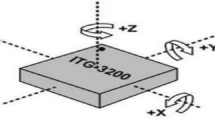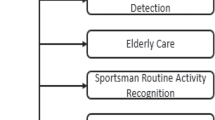Abstract
Sensor-based activity recognition can recognize simple activities such as walking and running with high accuracy, but it is difficult to recognize complex activities such as nursing care activities and cooking activities. One solution is to use multiple sensors, which is unrealistic in real life. Recently, learning using privileged information (LUPI) has been proposed, which enables training using additional information only in the training phase. In this paper, we used LUPI for improving the accuracy of complex activity recognition. In short, training is performed with multiple sensors during the training phase, and a single sensor is used during testing. We used four published datasets for evaluating our proposed method. As a result, our proposed method improves by up to 16% in F1-Score to 67% compared to the baseline method when we used random-split cross-validation of each subject.
Access this chapter
Tax calculation will be finalised at checkout
Purchases are for personal use only
Similar content being viewed by others
References
Bulling, A., Blanke, U., Schiele, B.: A tutorial on human activity recognition using body-worn inertial sensors. ACM Comput. Surv. 46(3) (2014). https://doi.org/10.1145/2499621
Chang, Y., Mathur, A., Isopoussu, A., Song, J., Kawsar, F.: A systematic study of unsupervised domain adaptation for robust human-activity recognition. Proc. ACM Interact. Mob. Wearable Ubiquitous Technol. 4(1) (2020). https://doi.org/10.1145/3380985
Dernbach, S., Das, B., Krishnan, N.C., Thomas, B.L., Cook, D.J.: Simple and complex activity recognition through smart phones. In: 2012 Eighth International Conference on Intelligent Environments, pp. 214–221 (2012). https://doi.org/10.1109/IE.2012.39
Dietterich, T.G.: Ensemble methods in machine learning. In: Multiple Classifier Systems, pp. 1–15. Springer, Heidelberg (2000)
Gauraha, N., Carlsson, L., Spjuth, O.: Conformal prediction in learning under privileged information paradigm with applications in drug discovery. In: Gammerman, A., Vovk, V., Luo, Z., Smirnov, E., Peeters, R. (eds.) Proceedings of the Seventh Workshop on Conformal and Probabilistic Prediction and Applications, Proceedings of Machine Learning Research, vol. 91, pp. 147–156. PMLR (2018). http://proceedings.mlr.press/v91/gauraha18a.html
Inoue, S., Ueda, N., Nohara, Y., Nakashima, N.: Mobile activity recognition for a whole day: Recognizing real nursing activities with big dataset. In: Proceedings of the 2015 ACM International Joint Conference on Pervasive and Ubiquitous Computing, UbiComp ’15, pp. 1269–1280. Association for Computing Machinery, New York, NY, USA (2015). https://doi.org/10.1145/2750858.2807533
Kong, Q., Wu, Z., Deng, Z., Klinkigt, M., Tong, B., Murakami, T.: Mmact: A large-scale dataset for cross modal human action understanding. In: 2019 IEEE/CVF International Conference on Computer Vision (ICCV), pp. 8657–8666 (2019). https://doi.org/10.1109/ICCV.2019.00875
Krüger, F., Nyolt, M., Yordanova, K., Hein, A., Kirste, T.: Computational state space models for activity and intention recognition. a feasibility study. PLOS ONE 9(11), 1–24 (2014). https://doi.org/10.1371/journal.pone.0109381
Lago, P.A., Matsuki, M., Inoue, S.: Achieving single-sensor complex activity recognition from multi-sensor training data. ArXiv abs/2002.11284 (2020)
Lambert, J., Sener, O., Savarese, S.: Deep learning under privileged information using heteroscedastic dropout. In: The IEEE Conference on Computer Vision and Pattern Recognition (CVPR) (2018)
Lapin, M., Hein, M., Schiele, B.: Learning using privileged information: Svm+ and weighted svm. Neural Netw. 53, 95–108 (2014). https://doi.org/10.1016/j.neunet.2014.02.002. https://www.sciencedirect.com/science/article/pii/S0893608014000306
Li, X., Du, B., Xu, C., Zhang, Y., Zhang, L., Tao, D.: Robust learning with imperfect privileged information. Artificial Intelligence 282, 103246 (2020). https://doi.org/10.1016/j.artint.2020.103246. https://www.sciencedirect.com/science/article/pii/S0004370220300114
Liu, L., Peng, Y., Wang, S., Liu, M., Huang, Z.: Complex activity recognition using time series pattern dictionary learned from ubiquitous sensors. Information Sci. 340–341, 41–57 (2016). https://doi.org/10.1016/j.ins.2016.01.020. https://www.sciencedirect.com/science/article/pii/S0020025516000311
Mao, D., Lin, X., Liu, Y., Xu, M., Wang, G., Chen, J., Zhang, W.: Activity Recognition from Skeleton and Acceleration Data Using CNN and GCN, pp. 15–25. Springer, Singapore (2021). https://doi.org/10.1007/978-981-15-8269-1_2
Morales, F.J.O.N., Roggen, D.: Deep convolutional feature transfer across mobile activity recognition domains, sensor modalities and locations. In: Proceedings of the 2016 ACM International Symposium on Wearable Computers, ISWC ’16, pp. 92–99. Association for Computing Machinery, New York, NY, USA (2016). https://doi.org/10.1145/2971763.2971764
Reiss, A., Stricker, D.: Introducing a new benchmarked dataset for activity monitoring. In: 2012 16th International Symposium on Wearable Computers, pp. 108–109 (2012). https://doi.org/10.1109/ISWC.2012.13
Roggen, D., Calatroni, A., Rossi, M., Holleczek, T., Förster, K., Tröster, G., Lukowicz, P., Bannach, D., Pirkl, G., Ferscha, A., Doppler, J., Holzmann, C., Kurz, M., Holl, G., Chavarriaga, R., Sagha, H., Bayati, H., Creatura, M., Millán, J.d.R.: Collecting complex activity datasets in highly rich networked sensor environments. In: 2010 Seventh International Conference on Networked Sensing Systems (INSS), pp. 233–240 (2010). https://doi.org/10.1109/INSS.2010.5573462
Tang, F., Xiao, C., Wang, F., Zhou, J., Lehman, L.w.H.: Retaining privileged information for multi-task learning. In: Proceedings of the 25th ACM SIGKDD International Conference on Knowledge Discovery & ; Data Mining, KDD ’19, pp. 1369–1377. Association for Computing Machinery, New York, NY, USA (2019). https://doi.org/10.1145/3292500.3330907
Vapnik, V., Izmailov, R.: Learning using privileged information: similarity control and knowledge transfer. J. Mach. Learn. Res. 16(61), 2023–2049 (2015). http://jmlr.org/papers/v16/vapnik15b.html
Vrigkas, M., Kazakos, E., Nikou, C., Kakadiaris, I.: Human activity recognition using robust adaptive privileged probabilistic learning. In: Pattern Analysis and Applications (2021). https://doi.org/10.1007/s10044-020-00953-x
Vrigkas, M., Kazakos, E., Nikou, C., Kakadiaris, I.A.: Inferring human activities using robust privileged probabilistic learning. In: 2017 IEEE International Conference on Computer Vision Workshops (ICCVW), pp. 2658–2665 (2017). https://doi.org/10.1109/ICCVW.2017.307
Author information
Authors and Affiliations
Corresponding author
Editor information
Editors and Affiliations
Rights and permissions
Copyright information
© 2022 The Author(s), under exclusive license to Springer Nature Singapore Pte Ltd.
About this paper
Cite this paper
Adachi, K., Lago, P., Hattori, Y., Inoue, S. (2022). Using LUPI to Improve Complex Activity Recognition. In: Ahad, M.A.R., Inoue, S., Roggen, D., Fujinami, K. (eds) Sensor- and Video-Based Activity and Behavior Computing. Smart Innovation, Systems and Technologies, vol 291. Springer, Singapore. https://doi.org/10.1007/978-981-19-0361-8_3
Download citation
DOI: https://doi.org/10.1007/978-981-19-0361-8_3
Published:
Publisher Name: Springer, Singapore
Print ISBN: 978-981-19-0360-1
Online ISBN: 978-981-19-0361-8
eBook Packages: Intelligent Technologies and RoboticsIntelligent Technologies and Robotics (R0)




